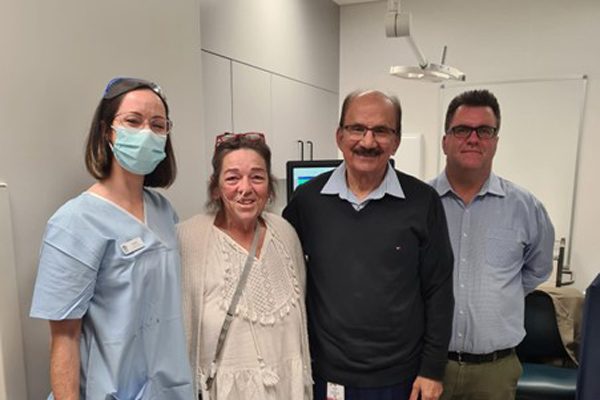New gold standard gastroenterology procedure takes place at STARS

Pictured from left to right – Clare (Oesophageal Function Testing Clinical Nurse), patient Donna, Dr Khan and Peter (Medtronic Representative).
The Oesophageal Function Testing Service at STARS is identifying swallowing and digestive issues with high-resolution oesophageal impedance manometry (HRIM) procedure.
HRIM is used to assess pressure and motor function of the oesophagus (food pipe) and is a valuable addition to STARS. It provides an important diagnostic tool for patients with symptoms such as gastric reflux, heartburn and swallowing difficulties.
Normally food moves down the oesophagus through wave like muscular contractions called peristalsis, but issues can occur with this motion and with the upper and lower sphincters (valves) of the oesophagus.
HRIM involves passing a thin, flexible, lubricated tube through the nose, down the throat, oesophagus and into the stomach. Topical anaesthesia is placed to help numb your nose and throat to minimise this discomfort. The pressure sensors along the tube record the oesophageal motility contractions during swallowing. The sensors transmit their data to a computer, which converts it into a topographical pressure map.
Following HRIM, a pH catheter can be placed through the nose for a 24-48 hour period, to record the levels and changes in acid content in the oesophagus, before being removed.
Dr Mohammed Khan, a senior Consultant Gastroenterologist, who specialises in oesophageal disorders welcomes the addition of the procedure to STARS.
“HRIM is considered the gold standard in assessing oesophageal motility disorders. It uses a tube with the highest number of sensors, 36 sensors per centimetre, compared to previous manometry that typically only had five sensors. It offers improved uniformity, standardisation, greater reproducibility and sensitivity,” said Dr Khan.
“STARS is only the second Metro North facility to offer the procedure, after The Prince Charles Hospital. Having the procedure available at STARS will improve access for patients who require the test in a timely manner.”
This includes patients such as Donna, who was the first patient to undergo HRIM at STARS in July 2023. Donna had been living with debilitating symptoms for years, experiencing non-cardiac chest pain and heart burn and reflux induced coughing. Donna’s symptoms had a significant impact on her daily life as well as on her family.
“I experience vomiting regularly and this led to me getting aspiration pneumonia. I ended up in hospital with it several times. This procedure will hopefully provide some more answers to what is going on and help my doctor decide what to do next,” said Donna.
Donna was very impressed with the care she received from everyone at STARS.
“From the moment I arrived everyone was amazing. They spoke to me in a way I could understand, not in doctor’s terms, and I felt really respected. The first thing I am going to do when I get home is have a hot bath”. [Patients with the pH catheter aren’t able to shower or bath with it for the 48 hours].
